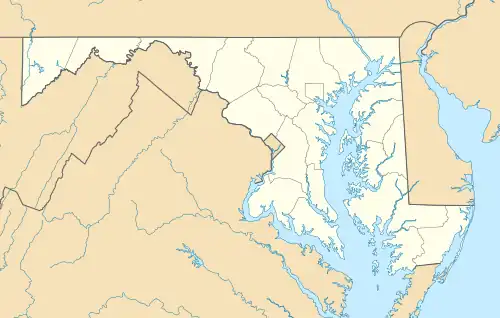Phoenix, Maryland | |
|---|---|
 Phoenix Location within the State of Maryland  Phoenix Phoenix (the United States) | |
| Coordinates: 39°30′59″N 76°36′58″W / 39.51639°N 76.61611°W | |
| Country | |
| State | |
| County | |
| Time zone | UTC-5 (Eastern (EST)) |
| • Summer (DST) | UTC-4 (EDT) |
| GNIS feature ID | 591002 |
Phoenix is an unincorporated community located in Baltimore County in the State of Maryland, United States. It is located at latitude 39°30'59" North, longitude 76°36'59" West.[1] The United States Postal Service has assigned Phoenix the ZIP code 21131.
Part of the area is also known as Jacksonville, although Jacksonville was once a separate community to the east.[2]
The NCR Trail runs through Phoenix, which hosts one of the rail trail's major parking lots.[3]
Phoenix has an elementary school, Jacksonville Elementary. It also has the Jacksonville Senior Center. The center hosts a variety of activities for seniors age 60 and over and is open five days a week. There is a fitness studio, multipurpose room with kitchen, classrooms, and staff and council offices.
The town also has two gas stations, a volunteer fire company and a post office.
Phoenix provided the setting for scenes in Baltimore native John Waters' 1972 cult classic film Pink Flamingos.
Phoenix was also the setting of Route 66 season 2 episode 7, "The Mud Nest", starring Martin Milner and George Maharis. Several local townspeople were featured in the episode.
Historic home Eagle's Nest was listed on the National Register of Historic Places in 1974.[4]
Fashion designer Jhane Barnes was born in Phoenix.[5]
Methyl Tert-Butyl Ether (MTBE) spill
Phoenix was the location of a January 2006 Exxon Mobil gas leak, in which over 26,000 gallons of gas seeped out of a punctured pipe at a station at the intersection of Maryland routes 145 and 146. The area affected by the gas leak was approximately one-half mile downhill from the location of the gas station. Six wells were contaminated, and 62 residential wells showed traces of Methyl Tert-Butyl Ether (MTBE). The state filed a $12 million suit against Exxon Mobil in April 2006. In September 2008, the state settled the case with Exxon Mobil, imposing a $4 million civil penalty. In addition, about 300 Jacksonville residents sought compensatory and punitive damages from the company worth several billion dollars. A jury awarded the plaintiffs $1B in punitive damages, which decision was later reversed. This was the largest amount of money ever awarded in history involving oil spills. In March 2009, a Baltimore County jury found Exxon Mobil liable and awarded compensatory damages to the plaintiffs. Several other cases were ongoing as of 2015.
References
- ↑ U.S. Geological Survey Geographic Names Information System: Phoenix
- ↑ U.S. Geological Survey Geographic Names Information System: Jacksonville
- ↑ "NCR Trail Parking". NCR Trail Snails. Retrieved February 12, 2017.
- ↑ "National Register Information System". National Register of Historic Places. National Park Service. April 15, 2008.
- ↑ Pedersen Budge, Rose Mary (November 21, 1985). "For practical, simple fashions, leave it to Jhane". Deseret News. Retrieved February 12, 2017.
